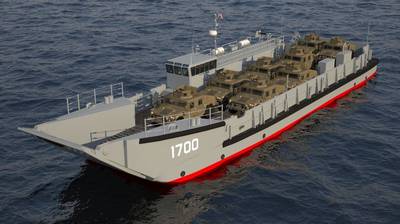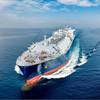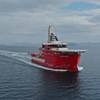US Navy Orders Two More Landing Craft Utility Vessels from Austal USA
Mobile, Ala. shipbuilder Austal USA has been awarded a $54,997,317 fixed-priced incentive (firm-target) contract modification for the construction of two additional Landing Craft Utility (LCU) 1700-class vessels for the U.S. Navy.
Austal USA was awarded an initial contract for the construction of three LCU 1700-class vessels, with options for an additional nine vessels, in September 2023. The potential value of the contract for up to 12 vessels is $379.7 million.
This contract modification brings the total number of LCU currently scheduled or under construction at Austal USA to five.
Paddy Gregg, CEO of Austal USA's parent company, Australia-based shipbuilding group Austal, said the contract modification confirms Austal USA’s successful start to construction of the first LCU vessel for the U.S. Navy, and again highlights the steel shipbuilding capability of Austal’s Mobile, Ala. facility.
“The United States Navy has recognized that Austal USA has made a great start to construction on the first LCU craft and has now exercised options for another two vessels; to be constructed at the Mobile, Alabama shipyard,” Gregg said.
“The Austal USA team continue to demonstrate their industry leading capabilities to manage multiple steel naval shipbuilding projects for the United States Navy such as Towing, Salvage and Rescue (T-ATS) ships and Ocean Surveillance (T-AGOS) ships.
“We look forward to seeing these LCU 1700 class vessels join the fleet in the coming years and thank the United States Navy for again showing their great confidence in Austal USA’s shipbuilding capabilities.”
The steel hull, LCU 1700-class are a heavy-lift capability with 170-ton payload capacity. They will be deployed with the U.S. Navy’s amphibious assault ships to support a range of military operations including the delivery of tracked and/or wheeled vehicles, troops and cargo from ship to shore, shore to shore, and back to ship.
The vessels have a roll-on/roll-off monohull configuration with hydraulically controlled bow and stern ramps that allow multiple vessels to connect and form a causeway for fast and secure unloading and loading. They are designed to be transported within, and load/unload from, the well decks of amphibious assault ships, carrying loads up to 3.5 meters high, above the vessel’s vehicle deck. With a crew of 13, each vessel can conduct independent open ocean transits or operations at sea with a range of 1,200 nautical miles (at 8 knots) and a top speed of 11 knots.












